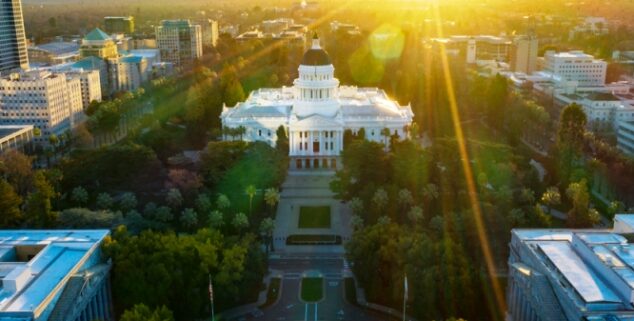News
Capitol rebuild in flux; foes battle Legislature over preservation
 The state Capitol in Sacramento surrounded by Capitol Park. (Photo: Merge Digital Media LLC, via Shutterstock)
The state Capitol in Sacramento surrounded by Capitol Park. (Photo: Merge Digital Media LLC, via Shutterstock)Preservationists understand that their appeal court victory this month will only delay a billion-dollar expansion of the state Capitol building, but they hope legislators will use the time-out to consider alternatives that would kill fewer trees, cost less money and keep Capitol Park more or less as generations of Californians have known and enjoyed it.
Earlier this month, a panel of California’s 3rd District Court of Appeal ruled against legislators and the Newsom administration, declaring they had failed to meet the requirements of the California Environmental Quality Act (CEQA), the state’s premier environmental protection law.
The justices concluded that the Legislature and administration did not properly show how a visitor center protruding from the west lawn would affect the unobstructed view of the historic building from Capitol Mall.
The justices overturned a lower court ruling that found the environmental reports were sufficient.
“Nothing in the EIR represents the view from Capitol Mall toward the Historic Capitol’s west façade once the visitor center is constructed,” according to the appellate court’s 59-page ruling.
That visitor center, which was added after the initial draft environmental impact report, would create “significant effects on the Historic Capitol, the seat of state government.”
The justices overturned a lower court ruling that found the environmental reports were sufficient. The appeal panel ruling essentially called for a do-over. Nothing in the most recent ruling, though, says the project can’t go forward.
That’s fine with the people who brought the suit that led to this month’s ruling.
“We aren’t hoping they’ll cancel the project. We don’t think that would be good for the people of California,” said Dick Cowan, spokesman for the preservationist group Save Our Capitol!
“We’re hoping this gives them an opportunity to pause and say, ‘Let’s think about some of these objections.” — Dick Cowan
Cowan, a former chair of the State Capitol Commission, said the members of his group support upgrades for the Capitol. But they don’t want a massive vanity project that gobbles park space and obstructs views of the historic building.
“We’re hoping this gives them an opportunity to pause and say, ‘Let’s think about some of these objections,” Cowan said.
The Capitol Annex project involves demolishing the existing 325,000-square-foot annex attached to the east side of the Historic Capitol. Built in 1952, the current annex is a crowded warren of mismatched office space contaminated with mold and asbestos.
In its place would rise a 525,000-square-foot building, which would provide more office space for the governor, legislators and their staff.
In 2017, an early version of the project was estimated to cost nearly $550 million. Estimates for the expanded project are closer to $1.2 billion
Initially, the Legislature called for a straightforward replacement of the annex. It now includes the two-level visitor center that would be partially underground in front of the west steps.
“The cost growth and the scope growth have been terrible,” said Cowan.
In 2017, an early version of the project was estimated to cost nearly $550 million. Estimates for the expanded project are closer to $1.2 billion.
Preservationists say lawmakers and their administration partners should consider placing the visitor center inside the existing building, an option that would create its own impacts to the historic structure. They also want designers to try harder to reduce the number of trees that would have to be moved or cut to make way for the new structures.
Earlier versions of the project – versions that were shown to the public – would have required removal of 20 to 30 trees. Newer plans would mean removing 56 trees and would affect a total of 133 trees.
“The project’s impact on aesthetics cannot be understood unless the project is seen.” — State appellate court, noting the lack of artists’ renderings.
The Department of General Services was tasked with preparing and circulating the environmental review documents. The justices ruled the department had downplayed how the plan might mar the most recognizable side of the Capitol.
“The new design would significantly impact the West Lawn as a historical resource because it would materially alter the West Lawn’s physical characteristics that convey its historical significance and justify its designation as a historical resource,” the ruling says. “The visitor center, with its above-ground entrance ramps, open-air lower plaza, higher upper plaza, and a skylight and railings, and its modifications to the West Lawn’s historic landscape will alter the scenic vista from Capitol Mall.”
How much it might change those views is unclear, largely because project planners offered no rendering of the completed structure. That won’t cut it, according to the ruling. “The project’s impact on aesthetics cannot be understood unless the project is seen.”
Legislators say they’re uncertain what their next steps will be.
“We are reviewing the decision in consultation with the administration and considering available legal options,” according to a joint statement released by Speaker Anthonty Rendon, D-Lakewood, and Senate Pro Tem Toni Atkins, D-San Diego.
Whether they will consider design options alongside their legal options remains to be seen.
Want to see more stories like this? Sign up for The Roundup, the free daily newsletter about California politics from the editors of Capitol Weekly. Stay up to date on the news you need to know.
Sign up below, then look for a confirmation email in your inbox.

Leave a Reply